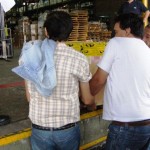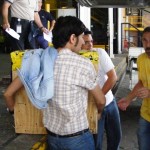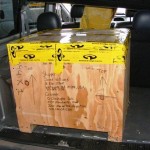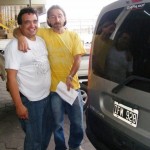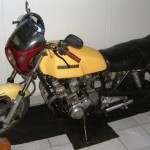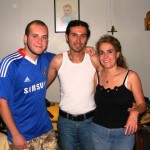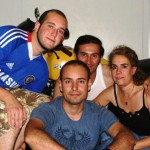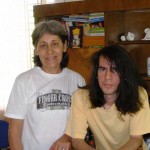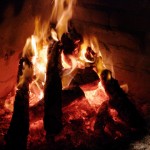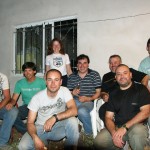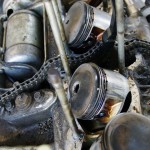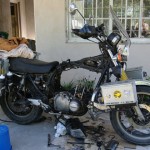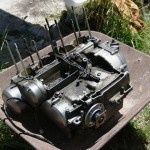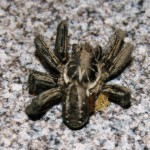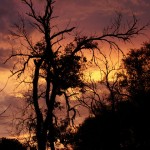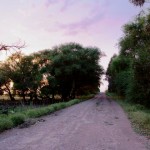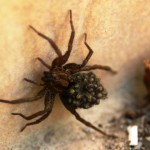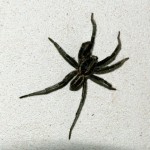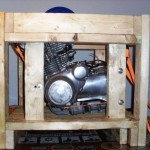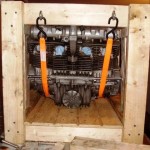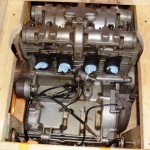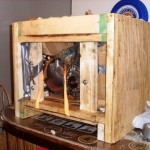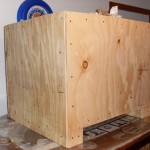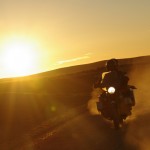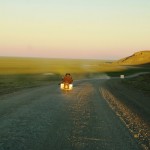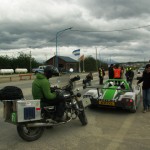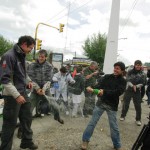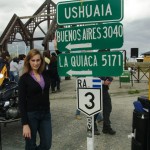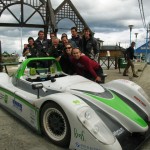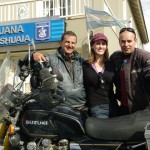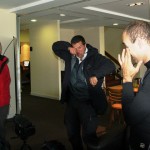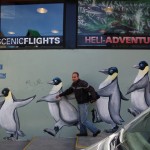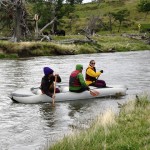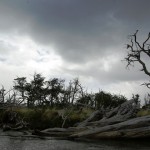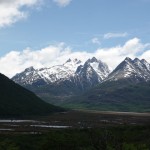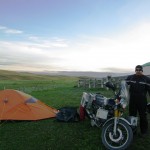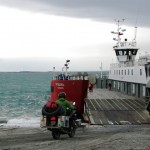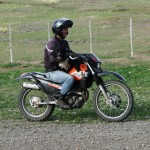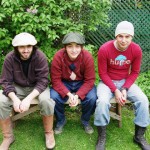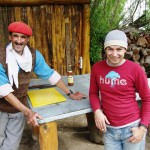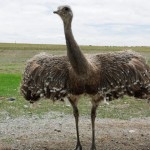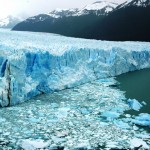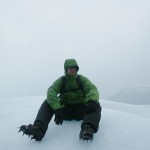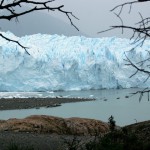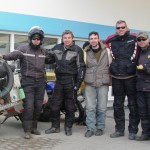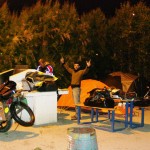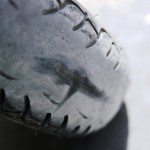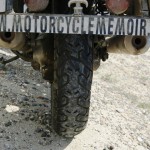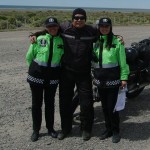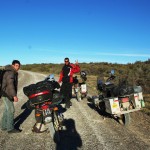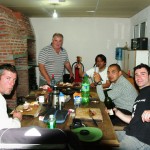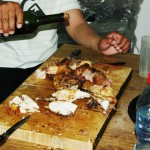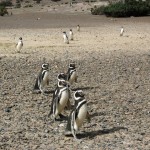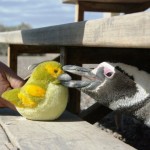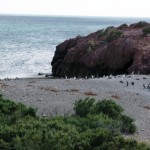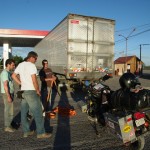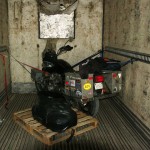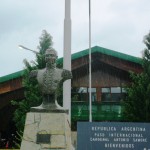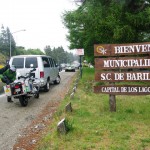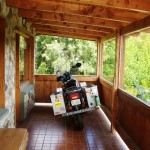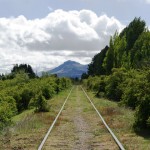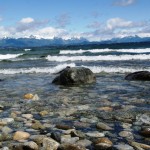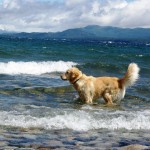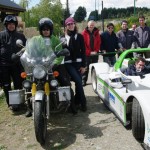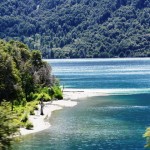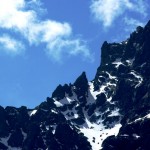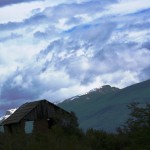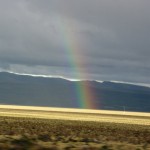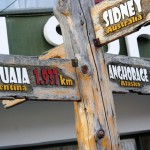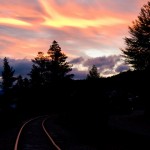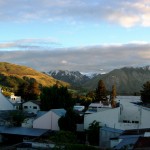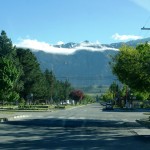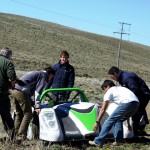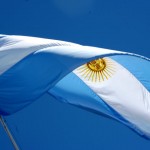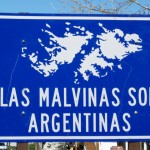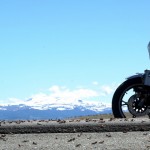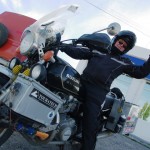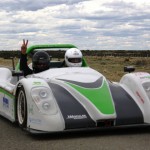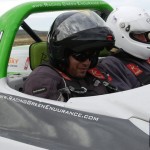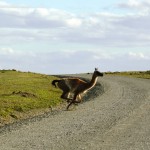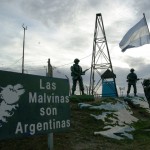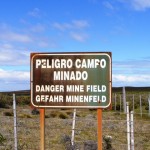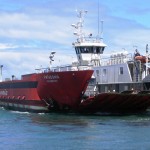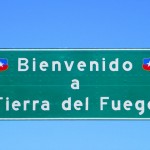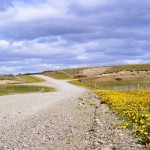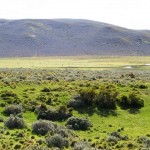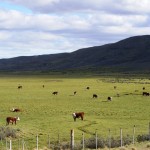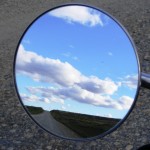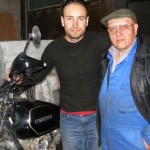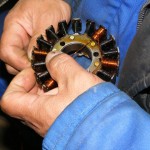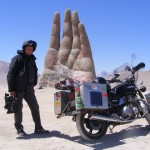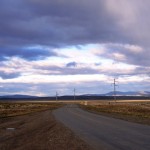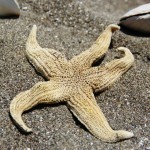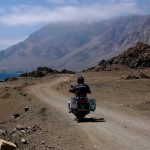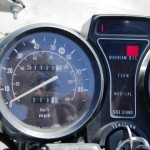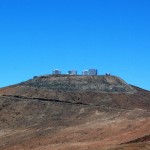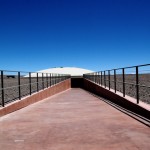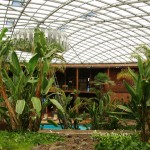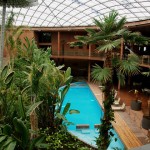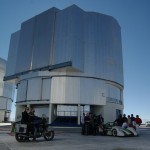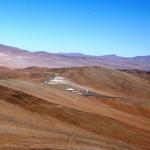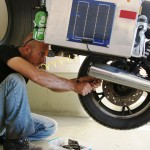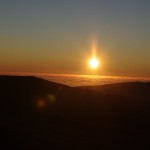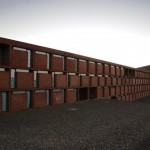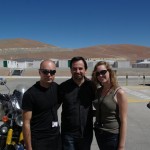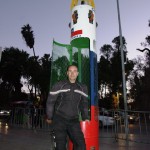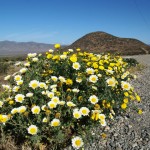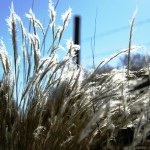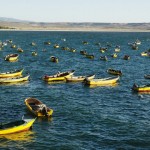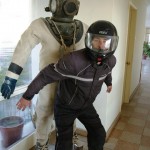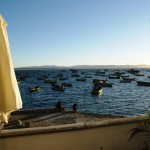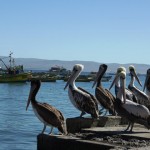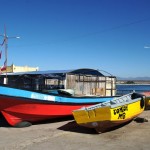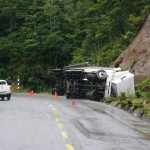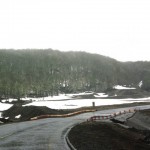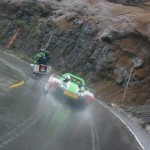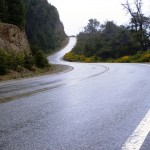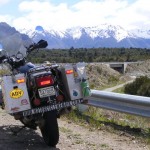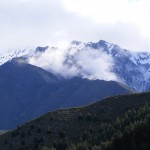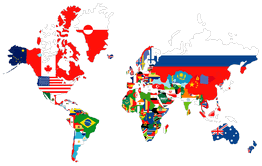I felt as if my right foot was on fire, but I blamed it on the wind. When the wind blows from the side, it pushes the heat of the engine sideways, hence the all familiar warm sensation, but this time my foot was actually burning. I looked down and found my right boot covered in hot oil and saw a cloud of smoke coming from the right tail pipe. The engine started to sound like a Chinese washing machine with a roll of quarters in it, and before I knew it, it lost compression all together. The tachometer needle dropped slowly from 6000 rpm to nothing, and I had to stop. I was broken down in Northern Patagonia, with 230 kilometers to the closest city, in temperatures as hot as Texas in July.
Two weeks ago, after 101 days of hard traveling, we rode gloriously into the end of the world, Ushuaia Argentina. With that I completed the longest leg of my journey, a distance of 26,400 miles from Helena Montana, to Arctic Circle and due south to the end of all roads: Ushuaia in Tierra del Fuego. I did this journey on a 28-year old motorcycle, which astonishingly made the grueling trip beyond the speculation of many.
It wasn’t just me who felt victorious, the Racing Green Endurance team was ecstatic. Setting a new world record, the SRzero electric car became the first electric vehicle in the world to successfully complete this distance on the longest road in the world: the Pan American Highway. The long journey was over and with that the filming of the documentary which Claudio shot from the back of my motorcycle.
Our parting was bittersweet as I bid farewell to Claudio and Paul as we had traveled together for so long. Although it was just another day for me, for Claudio and Paul, it was just the beginning as they flew back home to edit the hours of footage and get the episodes ready for the BBC. The eight-part documentary will start broadcasting on January 1st, from BBC World News so don’t miss it.
For the rest of the team, I wish them best of luck on their future adventures. They were a good bunch, and despite the differences we had, we got along well and worked towards a same goal in harmony. However hard it was to be on the road every day, it was an honor for me to be a part of this monumental undertaking and play a small roll in its achievement. These young guys showed how with determination everything is possible, even when they were laughed at every time the bottom of the super-low race car scraped on another speed bump. The electric car is a reality, believe it or not. I was skeptical from the second I laid my eyes on it in Mexico, but I was proven wrong. Big thumbs up to the RGE team.
The end of the world
Ushuaia sits at 54 degrees of latitude in the southern hemisphere and is the most southerly city in the world. Just a few kilometers to the south, the Beagle Channel separates the last sizable land mass from the rest of the freezing waters of Antarctica. Here at the end of the world or as the locals like to call it: “The Beginning,” life is as laidback as it comes. It’s really no different from the Alaskan communities I’ve visited and the mental attitude is the same. Since Cynthia was flying back to California, we decided to spend a few days together in the wild expanses of southern Patagonia before saying goodbye.
We visited the penguins, and canoed to a few island south of the Beagle Channels and made some new friends. Between the touristy visits and recovering, I chased after new tires as the rear tire on the GS was worn out beyond safety (the horrible Pirelli MT66, of course) in only 3000 miles, and I needed new tires to cover the distance of over 3000km to Buenos Aires. The more I searched the less I found, and I had to ride on these tires from lack of a choice.
The bike needed some seals and gaskets to stop the oil leaks here and there, and since there were no parts available for this bike in South America, I contacted the Z1 Enterprise, a company that specializes in old Japanese motorcycles. I had a positive experience from my previous purchases from them and I knew if there was one place that could locate all the parts I needed it was them. With only one email (I had no phone access to call them directly), Jeff Saunders of the Z1 Enterprise answered my pleas and the Z1 Enterprise officially became our parts sponsor. I sent a long list of items to Jeff, and he started pulling parts off the shelves and direct ordering the rest from Suzuki. With that out of the way, Cynthia and I started the 600km journey back to Rio Gallegos in light snow.
The wind started to blow, and as Patagonia is famous for its mighty winds, we had every right to be apprehensive of this phenomenon. We crossed a 120km gravel section, survived a very bumpy ferry ride and camped on a rancher’s land at twilight the first day. The winds were still manageable and calmed down as we got to Rio Gallegos. We visited our friends, the Sanchez’s 100+ year old ranch, Chali Aike, on the way to El Calafate and got the taste of ranch life. In El Calafate, after a day on the glacier, Cynthia got aboard a plane to Buenos Aires to get back to California.
Alone
In every relationship, there’s always a compromise. I always thought that you either have a choice to be in a relationship and be irritated, or to be lonely and not irritated. Now that Cynthia was gone, I was both! I felt alone. I was in a strange country with no knowledge of the language, or a single person I could call friend. We had rushed so hastily to the airport that I had no idea where I was in relation to the roads. I was truly lost, emotionally and physically. The only thing familiar to me was the old faithful GS850 that didn’t let me down. I walked out of the airport disoriented, sad and somewhat petrified. I had no GPS maps for southern Patagonia, and all I could do was to match the coordinates to my paper map and go from there. I rode out in mild winds towards Rio Gallegos with a million thoughts in my head and uncertain of the imminent future.
The wind
Somehow in the dark, I miraculously found the ranch we stayed at on the way to Calafate. Since the ranch was on a totally different road, I had no idea how I got there, but getting lost actually saved the night. The Sanchez family received me with a dinner of spaghetti and lamb and we capped off the night with Mate, the national Argentine drink.
In the middle of the night I woke up to the atrocious sound of the wind lashing the tin roof of the building and wondered how tomorrow was going to fare. In the morning, I walked outside and could barely stand straight as the wind forced me back in the house. The radio announced five days of wind averaging 80 to 100kmh in the provinces of Tierra del Fuego and Santa Cruz; where exactly I would be traveling. I had to make the call before it was too late. I could either stay put at the ranch and wait out the winds, or I could tough it out and try to out run it before it got worse. Since I needed the parts that Jeff was sending me to Buenos Aires, I decided to leave and dash for the capital city.
The wind blew from the Northeast and it was a tail-wind until I reached the crossing of the Ruta 3, the highway that runs North/South on the Atlantic coast of Argentina. This is where things started going from bad to worse. I’ve ridden this motorcycle for so long that I know its every move, every flaw and every handling glitch, and I was confident that I could ride it in any weather on any continent. And I have. I’ve ridden it in snow, in sand, in the mighty winds of southern Wyoming and New Mexico, the Dempster Highway in Yukon, the floods of Central America, and the high mountain roads of the Andes, so my confidence wasn’t from a macho ego; it was based on the hard-earned experience of thousands of hard miles. But there was something different about this wind. It was constant.
It pounded me hour after hour without mercy to the point my neck was hurting from the force of the helmet pushing on my head. Every little hill I passed was a dangerous wind-stopper as it stopped the wind for one or two seconds and unleashed its full furry on the other side all at once. Every truck that passed me on the opposite side promised a mighty blow and trashed me about the road. Sometimes there were three or four trucks passing me simultaneously and that was the absolute hell on earth. I stopped at every sheltered outcrop of rocks to catch my breath and relax my aching arms. I tried a few time to light up a cigarette and only once I succeeded. I took one puff, and the cigarette burned almost halfway with the wind.
And the land was flat. No shelter to pitch a tent or even a tree. I was sure that my tent would withstand these winds as it’s a four-season mountaineering tent, but the problem was pitching it. It was impossible for one person to hold the fabric down and erect the tent in this wind. I was ready to dig a hole and go underground if I couldn’t find a place soon as the wind intensified by the minute. The wind wasn’t just killing me; it was killing my precious fuel in a land that gas stations are more scarce than hen’s teeth. I could see the fuel gauge needle moving towards empty, but there was nothing I could do. I kept on rolling the throttle and hoped for a gas station, or I would be doomed.
In a distance I saw two giant hills and a wide open valley after that. I had a feeling I was going to get hit hard there as the valley dipped very low, and I knew it would be a disastrous wind tunnel. I just didn’t know how bad. As I entered the hills the wind stopped, but I could see a bridge over two small ponds down the valley that looked horrifying. The shallow water of the ponds had one foot or bigger white-caps, and every bush and tall grass was flattening to the ground. It was too late to stop, and I emerged out of the shelter of the hills. The gale hit me on the left side and brought the 800lb hunk of iron traveling 60mph to a halt. I had the throttle wide open and kept down shifting for a hope of getting out of this tunnel, but the bike came to a stop a few feet before the bridge in the middle of the road and stalled. I held on to it with everything I had as I knew if I dropped it, I would never be able to pick it up in this wind. I was at a 45 degrees angle with my left foot on the ground and trying to save the bike from blowing away.
I heard a loud honk from a truck coming at me from behind, but I couldn’t move. I tried to start the bike, but to no avail so I stayed put in the middle of the road motionless. The truck swerved hard to pass me and his blast hit me even harder than the wind. I had to get off the road but my legs were trembling and the bike wouldn’t turn on. Pushing it was out of the question as the wind was hitting me straight on from the side and front. I opened the choke all the way, and the bike rumbled to life. I ushered it to the shoulder with the kickstand down. Even with the kickstand down I still had to lean on it to keep it from toppling over.
I was pinned in the worst place I could possibly be, and I couldn’t move. So I waited. I started to see a pattern in the gusts. The wind blew a steady 90-100kmh and that was manageable; it was the gusts that made it impossible to move. The gusts weren’t short, they would last 15 seconds, and then they would calm down for 10 second before hitting again. For about 5 minutes I studied the wind and waited impatiently as my fingers started to get numb from the cold. The temperatures were well below freezing, and the wind-chill was intolerable.
I counted 1, 2, 3, 4,… and on 10 I made a run for it full blast on to the bridge to other side. I rode like a bat out of hell and finally stopped behind another hill to catch my breath. I kept the bike running this time. The temperatures were so cold and the wind so fierce that it cooled off the engine in less than two minutes where I was pinned down on the road, that’s why I had to choke the bike. I was scared beyond belief. If someone gave me a bus ticket in exchange for my bike on that bridge, I would have happily done so, but now I was coming out of the shock. I kept telling myself that this was stupid. It was suicide. I saw a building that looked like a gas station in a distance. I ran for it. Later I learned that two motorcyclists died that very same day on this road in the wind. I was very lucky to be alive. My heart goes out to their families.
Out of gas
I rolled into the quiet gas station and was disheartened to see a sign on the pump: Out of gas. I noticed two other motorcycles parked in front of the building and a guy who seemed to be one of the riders came up to me to give me the news. He asked me how much fuel I had left and when I shook my head, he said in perfect English: “Well, you’re fucked brother.” There was no gas anywhere for another 100km.
Jorge Zmud or “Tati” as his friends call him is an Argentine who lived in Florida for 10 years. He and his friend Fokundo rode their 125cc Yamaha’s from Mar del Plata, Argentina to Ushuaia and were on their way back. They had a close-call as well on the bridge with Fokundo being blown over and falling. Tati told me they were going nowhere in this wind and they were waiting it out. That sounded like a smart decision so I joined them inside for mate and empanadas. The weather turned for the worse with snow flying horizontally and temperatures dropped even more. In the meantime, we sucked out 4 liters of gas out of their tanks to put in my gas-guzzler four cylinder engine to enable me to get to the next station.
Tati called his girlfriend, and she updated us with good news; the wind was supposed to die down in a few hours and we had a clear window to ride out of hell. While we waited, a group of Brazilian motorcyclists joined us with their disbelief of the wind and empty gas tanks. We waited for three and half hours before we could ride again. I wore everything I owned and still shivered as I walked outside of the building. Tati, Fokundo and I rode out north to the next gas station and from there we decided to travel together since we were going to the same town anyway.
These guys were heaven-sent as they knew the area and knew the language. They were both good lads with lots of stories to tell and they traveled the same way I do: camping and cooking their own food. We became fast-friends in no time. We camped the first night at a campground which turned out to be free since the guard wasn’t there. The next day we covered 500km to the coast on the Atlantic. The weather started to warm up and mercifully, the wind was almost gone. Occasional gusts shook the bikes but nothing we couldn’t live with. Our plan was to stop at Punta Tomba, the biggest penguin reserve in Argentina (top three in the world) to see the giant flightless birds. I saw the penguins with Cynthia in Beagle Channel, but it was so cold and windy that day that I didn’t care for them too much. This time we would see them in much better weather and on our own pace.
The tire dilemma
My rear tire started to get really bad to the point that the cotton threads holding the plys together started to show. It was scary riding on it, but I had no choice. We kept pushing towards Comodoro, the biggest city closest to us and the tire kept getting worse. After calling around for almost two hours, we located a no-name tire that fit. It was wider than the original, but the same height and size, so I went for it. In México City, I purchased four new Pirelli MT66 (they are awful, think twice before handing your money over for this garbage), two fronts and two rears and used three out of four. The one leftover was a front tire which I didn’t need, but didn’t want to leave behind either. I hauled this garbage tire all the way with me and in this town, I found a customer for it. A guy wanted the tire so I sold it to him for 400 pesos. My rear tire was 350 pesos and installation was 30 pesos. I scored 20 pesos which I tipped to the tire guy. Life was all good again. We stayed at a municipal gymnasium for free that night, thanks to Tati’s fast-talking, and treated ourselves to a hearty camp dinner and cheap wine. We crashed like logs.
Amongst the penguins
The road to Punta Tomba took us through the countryside with nothing but deep gravel. The roads were new with no potholes so we unleashed the bikes 60mph on deep gravel, occasionally sliding and skipping, but we just gave it more gas. In 100km we didn’t see any cars, and we rode Dakar style on the pegs over the rolling hills. It was a much needed joy run, and I was impressed with Tati’s dirt riding skills. I chased him for an hour to catch up with him, and when I finally did, he was slowing down because we were at the end of the road. There’s only one secret to dirt riding: being fearless enough to give it more gas when the bike goes where you don’t want it to go. I think most people who fall and hurt themselves dirt riding are those who are scared of going fast. This 28-year old road bike was nothing short of a KTM on these roads, it just lacked the suspension travel which wasn’t important anyway since the road was as flat as a mirror.
We reached the penguin reserve at dusk and were informed that there was no camping allowed anywhere, and it was closed until 8am the next morning. So Tati got to work and after talking to the park ranger for 10 minutes, we even got invited to stay inside the ranger’s house with steak dinner. I don’t know what he told him and I don’t care, but I’m loving this guy. The dinner was exquisite, and the company a typical warm Argentine camaraderie. The admission fee was 35 pesos each which they waved, and we were the only people walking with the penguins for two hours.
This reserve is packed with over a million penguins and they are as fearless as they come. They walked right towards us, and some even poked their beaks in the camera sunshade. The penguins I saw in South were lazy and stupid looking, but these guys were lively and cheerful. This visit was the most amazing experience of my stay in Argentina to this day, and it will be hard to beat.
The disaster
The weather kept getting hotter, and we started to shed off our long johns and ski gloves. We camped in a beach town the next night, and it was almost too hot to sleep in the tent. At 8am I ran out of the tent with sunburn as the tent turned into a solar oven. We cooked some eggs for breakfast and decide to leave after lunch so we can do some chores around the camp: cleaning helmets, chains, checking the oil, tire pressure, mending clothes and socks and of course drinking mate. Around 1pm, we finally got on the road and made 200km before stopping for fuel. I told the guys to go ahead as I would catch up with them on the road. I wanted to get my MP3 player hooked up so I could listen to some music. I got back on the road maybe only 15 minutes after they left and cruised about 70 to 75mph to catch up with the slow pokes on 125cc Yamahas. And that’s when the bike broke down.
The engine was so hot that I couldn’t keep my face close to it to see where the oil was coming from, and one small try to restart the bike (after adding oil) disheartened me. It sounded like the pistons were scraping the cylinder walls and I stopped. I was frying in my protective gear in the full sun, so after taking off my jacket, I tried pushing the bike. I don’t know what I was thinking, but after 2 inches of hard push I gave up. The bike wasn’t going anywhere.
I tried to stop some small pickup trucks but I soon realized that there was no way of getting the bike in the bed of a pickup without ramps and even with ramps, it would take a few people to push this monster up there with no power. The search for a pickup truck towing a trailer turned out to be futile, and as the sun blazed on my head, I got more nauseated. I flagged down a semi truck and he stopped. With my 50-word Spanish vocabulary I got the message across that the motor blew and I needed to get to the next gas station where the guys would likely be waiting for me. The semi was empty with plenty of room, but again there was no way of getting the bike 6 foot high in the air to load it in the trailer.
Thinking the unthinkable
Only one option remained as I was as far from any civilization as could be: to tow the bike behind the semi with a tow strap. Towing a motorcycle is illegal in the United States and for a good reason; it’s extremely dangerous. What keeps the motorcycle upright is the power of the engine to the rear wheel which allows it to maneuver with accelerating and leaning under power. When it’s towed, the leaning becomes obsolete as the tow rope passes between the forks and the power is coming from the tow vehicle. The rider has to sit down on a death-trap and follow the tow vehicle with no control whatsoever and if anything goes wrong, the bike and riders are sure to be dragged behind the truck until the driver realizes the mishap.
I had no other choice. I wrapped the orange strap carefully around the frame and tethered my life to the semi truck ahead of me. The problem was that the strap was too short, and since I was riding behind the trailer, the driver had no way of seeing me. He asked me how fast he should go and the only high number in Spanish I remembered was cincuenta (50) so I uttered it with fear. He shook his head in agreement and started to pull me off. The strap tightened and off we went after a couple of jerks. The gas station we were trying to get to was 58km away and I think I lost just that much weight in pounds sweating and cursing at the driver as he sped up to 80kmh, well beyond my comfort zone. I held on for dear life and didn’t blink so I could take the slack out of the tow line every time he slowed down with gently using the rear brake. Every truck that passed us on the opposite way blasted me, and I shivered at the thought of losing control. Mile after mile, I sweated and held on for the safety of the gas station which seemed to be on the far side of the moon. Finally the truck started to slow down, and I kept a tight rope between us as he pulled in the station. From the corner of my eyes, I saw my biking buddies coming over camera in hands snapping pictures of the stupid scene.
Tati came to my rescue one more time as he worked out a deal with the driver to take the bike and me to the next town, 170km away so we could figure out a way to fix it. He agreed on 150 pesos but one problem remained. We still had no ramp. We rounded up a few hefty guys and as I watched in awe, they lifted the heavy beast 6 feet off the ground and into the back of the forty- foot trailer. We strapped it down and headed out on the road again, due north.
We stopped at a truck stop right before the town to figure out what we could do as Tati and Fokundo had a reunion to attend at 5p.m. the next day 450km away. Tati suggested taking the bike to his ranch, about 40km from Mar del Plata where I would have a place to work on it, and I could stay as long as I needed to for free. Again, I had no choice and his offer was hard to resist, so I agreed. The truck driver would take the bike to a transport company in the morning to be shipped and I would catch a bus to the ranch to meet the guys. I bought dinner for the very helpful truck driver and my new friends and we slept at the back of the semi-trailer that night next to rotting tomatoes and cabbages. The next morning, we shipped the bike for 450 pesos to Mar del Plata, and I got on the bus for another 150 pesos myself to meet it. The day after tomorrow is a holiday in Argentina so I have to wait another day to pick up the bike from the trucking company. Then, I have to rent a small pickup truck to take it to Tati’s place 40km away and find out what’s actually wrong with it.
As I’m writing this very long post in the bus station, I’m grateful for all the help and suggestions anyone can offer as I’m in a pinch here. This bike is my only ride and what I have on it are my only worldly possessions. When I started this journey back in August of 2009, I sold everything and I donated every piece I had left including this bike to our non-profit organization. If I can’t fix it here, I’ll have no choice but leaving it behind to cut the losses. Purchasing another motorcycle would be extremely expensive in Argentina as every imported thing is taxed 200%. An old shaggy Kawasaki KLR costs around $8000 USD here, and I honestly have no more money to afford that kind of spending. If the heads and cylinders are beyond repair, shipping the parts from United States will be outrageously expensive even if I can find the parts for free. Cross your fingers and wish me luck as I’ll try my best to get this old gal back on the road.
I’m not giving up, bike or no bike, I’ll continue this journey. Donkeys are cheap down here so stay tuned.
Chris Sorbi

